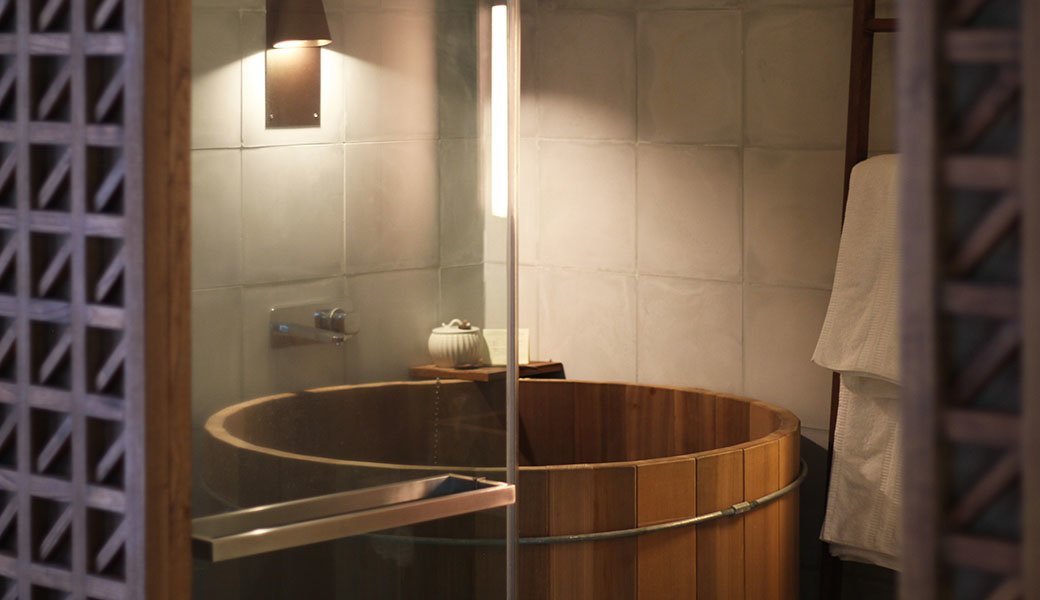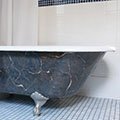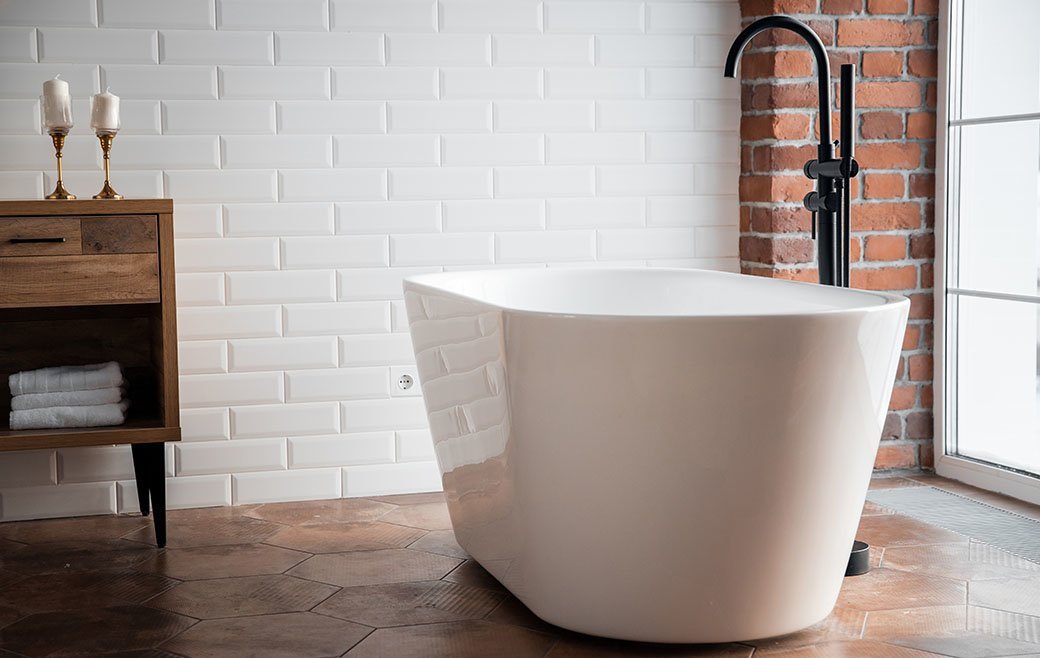BestReviews is reader-supported and may earn an affiliate commission. Details

This is a tub you can truly relax in with adjustable body massage and whirlpool jets.
Spacious, freestanding acrylic tub with a built-in faucet. Equipped with 10 air massage jets and 10 whirlpool jets. Air massage function uses tiny bubbles to relax soft tissue. Features an underwater chromotherapy light to create the ultimate relaxing bath experience. Made of high-quality 100% high-gloss acrylic.
Installation can be a bit difficult for this model, so it is best to consult a professional.

We love the elegant curves of this budget-friendly freestanding tub.
Large, 67-inch tub made of 100% white gloss acrylic and durable fiberglass. Ergonomic design is perfect for laying back for a long soak. Enjoy the deep, 15-inch soaking depth with an overflow drain to minimize mess. Despite its size, the tub is lightweight, making installation easier.
Some noted that the plumbing that comes with this tub appears cheaply made.

This beautiful black-finished tub will top off any unique taste while remaining perfectly functional and stylish.
Manufactured with 2 finish options of matte or gloss finishes. Originally made from high-quality materials with a slanted back on either side for the best soaking experience.
Inside fitting is narrow.

This 1-person, walk-in model is an ideal choice for those special mobility requirements.
Constructed with 100% glossy white acrylic. Has ergonomic control knobs for simple use. Made with an integrated seat to allow for soaking up to the shoulders. Includes the faucet and other fixtures needed for immediate installation.
Product is pricier than other options.

With a deep, 15-inch soaking depth, you can soak the day away in this acrylic freestanding tub.
Designed with a graceful slope for lumbar support and with a high fill line for a deep and relaxing bathing experience. Made of 100% glossy white acrylic material, with durable fiberglass reinforcements. High-gloss resin coating is easy to clean. Double-walled insulation keeps your bath hot longer.
This model does not include a faucet.

We recommend these products based on an intensive research process that's designed to cut through the noise and find the top products in this space. Guided by experts, we spend hours looking into the factors that matter, to bring you these selections.
Considered
Consulted
Researched



Buying guide for Best freestanding bathtubs
While they look modern and elegant, freestanding bathtubs actually have a long history. Back before built-in tubs were the go-to for most bathrooms, every tub was freestanding.
As the name suggests, a freestanding tub is simply a bathtub that sits on its own and is not built into or otherwise attached to a wall. It is this independence from the rest of a bathroom that gives a freestanding tub its versatility and creates an attractive focal point for the room. And, yes, they can be super comfortable for those who like to enjoy a long soak!


Key considerations
Construction
Like other tub types, freestanding bathtubs can be made of a variety of materials. Whichever material you choose, it should be scratch and stain resistant. The more common tub materials include the following:
Acrylic: Fiberglass-reinforced acrylic is standard for the majority of freestanding bathtubs. This material is lightweight, affordable, and durable. A double-walled acrylic tub retains heat better than a single-walled tub.
Cast iron: This classic tub material is durable but very heavy. If you’re partial to long soaks, consider a material that retains heat, such as cast iron.
Copper: While expensive and heavy, it’s hard to beat the visual appeal of a copper tub.
Stone: This is another material that is sometimes used to create durable and elegant tubs that retain heat, but it is also extremely heavy and difficult to safely install.
Design
From traditional to modern, freestanding tubs come in a wide variety of types and shapes. Whichever type or shape you select, it should be comfortable, with an ergonomic design that enhances everything from quick baths to longer soaks.
Types: Popular types include clawfoot, single/double slipper (with one or two raised ends), single/double-ended (with one or two rounded ends), and the round, tall-sided Japanese soaking tub.
Shapes: Freestanding tubs can also be found in a variety of shapes. While oval and rectangular are more common, other shapes include square, round, and even hourglass-shaped tubs.
Size
Built-in tubs are usually secured to a wall, but freestanding tubs don’t attach to the floor. Due to its weight and balance, once you set a freestanding tub where you want it, it should stay put.
Much like type and shape, freestanding bathtubs come in a variety of sizes. These tubs typically start at 55 inches long and can reach 72 inches or more. Also, note how deep the tub is. Deeper tubs are better for soaking, while longer tubs are better suited for two people.
The downsides of a large tub are that it takes up more room in the bathroom, and it can be difficult to maneuver through any doors, hallways, and staircases necessary to reach the bathroom. Heavier tubs may also require additional structural support to the flooring before installation.
Installation
While you need some plumbing knowledge — or a plumber — to install a freestanding tub, the installation is not overly difficult. Be sure that the tub ships with detailed, step-by-step directions, preferably illustrated. An included tub kit that has a faucet, drain, and other hardware elements you need will also help to ease the installation process. See the FAQ section for more information on installation.


Features
Feet
Some freestanding bathtubs have a simple flat bottom that rests on the floor. Others have built-in feet. Claw feet, usually made of metal, are a common choice here, but tubs can come with different types of feet. Note that adjustable feet are helpful if you need to level the tub on an uneven surface to keep it from rocking.
Edge
Some freestanding tubs have a straight edge, while others have a curved lip. This can provide a smoother and more elegant appearance but also limit the types of faucets that you can install.
Fixtures
Faucets: While rare, some freestanding bathtubs include a faucet or handheld sprayer. If so, make sure the manufacturer also includes all the hardware necessary to install it. Of the three common faucet materials (bronze, chrome, and nickel), chrome is the least expensive, although it tends to show fingerprints and water spots more readily than the other two.
Drains and pipes: These are essential elements for bathtub installation and operation and are more commonly included with a tub than a faucet. Both drains and drain pipes can be constructed from a variety of materials, including brass, chrome, and plastic. If a freestanding bathtub does not ship with these elements, you’ll need to provide your own, which will add to the cost. On the upside, these tubs don’t usually don’t require a special type of drain.
Jets and lights: While rare, other additions to a freestanding bathtub include air/water jets and underwater lighting. While these can greatly add to the relaxation factor, they also add considerably to the cost.
Overflow
Common on bathtubs and sinks, an overflow protects against flooding your bathroom if you forget to turn off the faucet. Oddly enough, some bathtubs don’t include this feature, so be aware of this when shopping for a freestanding bathtub. While some freestanding tubs have a simple cutout for overflow protection, others include more ornate materials, such as brushed nickel.
Freestanding bathtub prices
Freestanding bathtubs start at around $600 and can reach prices of over $2,000. The average here is in the $700 to $900 range. Warranties for these tubs typically range from several years to a lifetime.
Inexpensive: At the lower price points, around $600 to $700, you can find simple acrylic freestanding tubs that are more compact and better suited for one person. These tubs have little in the way of advanced features and usually ship with few extras.
Mid-range: As the price increases, from $700 to $900, you’ll find larger tubs that can hold more than one person. Accessories such as drains and even faucets may be included, and the quality of these extras improves as the price increases.
Expensive: Peak pricing of $900 to $2,000 and more is usually reserved for tubs made of copper or another top-quality material, in addition to those tubs that incorporate whirlpool jets and lighting elements.
Tips
Add a shower. To extend the use of your tub, consider purchasing a shower conversion kit to go with it.
Try a slipper tub. For maximum comfort, consider a slipper tub. These freestanding bathtubs are raised at one or both ends, which can be more ergonomic and comfortable than other freestanding tubs.
Install a curtain. While you should install a hanging curtain if you add a shower unit to your freestanding tub, another benefit of a curtain is that it helps to retain heat in a cold bathroom.
Try a drop-in tub if budget is a primary consideration. It can be less expensive than a freestanding bathtub and easier and cheaper to install.


FAQ
Q. How difficult is it to install a freestanding bathtub?
A. While a freestanding tub can be a bit more difficult to install than a built-in tub, if you have moderate plumbing skills, you shouldn’t encounter too many problems. One of the more trying elements includes hauling the tub into place, but there are some precautions you can take to ease the process.
First, carefully measure the room where the tub will go. The room should fit the tub with an additional several inches between the tub and any walls (recommended space varies between 4 and 12 inches). You should also leave enough room to install and maintain the plumbing.
Next, measure all doors, hallways, and staircases through which you need to move the tub. This is particularly important if you’re installing it above or below the ground floor.
Finally, be sure that any floor you place the tub on can support the weight of the tub plus water plus you. This is particularly important if you buy a tub made of stone or cast iron.
Q. What type of faucet should I use with a freestanding tub?
A. The type of faucet you install largely depends on the design of the tub. As the majority of freestanding tubs don’t ship with a faucet, the choice of both type and style is entirely up to you. While some tubs provide multiple options for faucets, others will require a specific type. Some tubs include holes for the faucet. Other options include mounting the faucet on the wall or on the floor. There are also a variety of different styles available, from single handle or double handle to shower wand, in addition to materials like bronze, chrome, or nickel. If you’re unsure of what type of faucet to go with, contact the tub manufacturer for suggestions.
Q. How should I clean my bathtub?
A. You will need to regularly clean your tub to remove grime and soap scum. Depending on how often the tub is used, scrubbing once a month with a tub and tile cleaner should be enough. Just follow the directions on the cleaner for best results. You can also try this expert method for cleaning your tub:
Spray the tub surface with a solution of half vinegar and half warm water.
Let it stand for 15 minutes
Wipe down the tub with a sponge or cloth.
Rinse the tub with clean water.
Wipe down the tub again.
- Best Air Mattress for Heavy People
- Best SoundAsleep Air Mattresses
- Best Montessori Floor Beds
- Best Air Mattresses
- Best Bed-in-a-Box
- Best Intex Air Mattresses
- Best Queen Air Mattresses
- Best Down Pillows
- Best Makeup Vanities
- Best Hand Towels
- Wedge pillows can help with a number of sleep issues, according to experts
- The crowd-favorite Purple Mattress is $400 off this week
- How much does a mattress cost?
- Experts warn ‘springing forward’ is really affecting our health
- Want to save your relationship? Try sleeping with separate blankets
- Update all the beds in your home for spring with these affordable luxury sheets
- This duvet has almost 100,000 5-star ratings on Amazon, and it’s on sale for $26
- Presidents Day mattress deals are here
- How often should you replace your pillows? Way more often than you do
- Best under-bed storage bins
- If you sleep with a pillow between your legs — you're smart
- Embrace your desire to hibernate and elevate your winter sleep routine
- Yes, you absolutely need a human dog bed
- Get that perfect vacation sleep with these hotel pillows
- Score up to 74% off during Wayfair’s annual Bed and Bath Sale
- Santa’s home is on Zillow, and you can take an AI-powered tour
- The best deals of Nordstrom’s huge Fall Sale
- The best blankets, quilts and throws for cozy season
- Five Below’s ‘cozy season’ merch is selling fast
- Anthropologie has 40% off bedding and decor right now